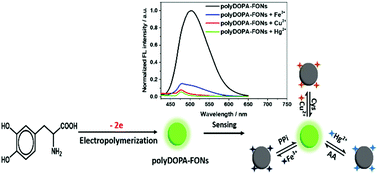Electrochemically assisted synthesis of poly(3,4-dihydroxyphenylalanine) fluorescent organic nanoparticles for sensing applications†
Abstract
3,4-Dihydroxyphenylalanine (DOPA), an analogue of dopamine (DA), has been used to prepare fluorescent organic nanoparticles (FONs) through the electrochemical oxidation method. The as-prepared polyDOPA-FONs have good optical properties and diverse functional groups on the surfaces and can serve as fluorescent probes for different targets. Herein, we have fully exploited the sensing properties of the polyDOPA-FONs. Fe3+, Cu2+ and Hg2+ could induce significant fluorescence quenching of the polyDOPA-FONs in water, and selective fluorescence quenching in three buffer solutions. A turn-off sensor was further established in a buffer solution system to detect Fe3+, Cu2+ and Hg2+ using the same polyDOPA-FONs. Based on the sensitive and selective fluorescence quenching in a different buffer solution, this sensor could also be applied to analyze the three metal ions in water samples. Finally, the possibility for the fabrication of an “ON–OFF” sensor and the recycling of the polyDOPA-FONs was confirmed by reversibly switching the fluorescence in Fe3+/pyrophosphate ion (PPi), Cu2+/cysteine (Cys) and Hg2+/ascorbic acid (AA) couples.



 Please wait while we load your content...
Please wait while we load your content...